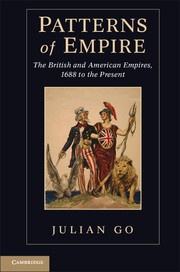Book contents
- Frontmatter
- Contents
- Preface and Acknowledgments
- List of Tables
- List of Figures
- Introduction
- 1 Imperial Paths to Power, 1688–1939
- 2 Colonial Rules
- 3 Hegemonies and Empires
- 4 Imperial Forms, Global Fields
- 5 Weary Titans
- 6 The Dynamics of Imperialism
- 7 Conclusion
- Appendix Notes on Data
- Archives and Abbreviations
- References
- Index
1 - Imperial Paths to Power, 1688–1939
Published online by Cambridge University Press: 05 June 2012
- Frontmatter
- Contents
- Preface and Acknowledgments
- List of Tables
- List of Figures
- Introduction
- 1 Imperial Paths to Power, 1688–1939
- 2 Colonial Rules
- 3 Hegemonies and Empires
- 4 Imperial Forms, Global Fields
- 5 Weary Titans
- 6 The Dynamics of Imperialism
- 7 Conclusion
- Appendix Notes on Data
- Archives and Abbreviations
- References
- Index
Summary
Behold! Behold! An Empire rise!
– Francis Hopkinson, from an ode distributed on July 4, 1788, Philadelphia[I]t is safe to assume, as a rule, that Americans are actuated by much the same ideas, instincts, motives, and modes of thought as their fellow-kinsmen in the Old World.
– Edward Dicey (1898)Expansion has ever been the instinct of the United States. The very symbol of the Union is an Eagle and the Eagle is a bird that spreads its wings.…Compared with the Eagle the British Lion treads mother earth like a tortoise. And no Eagle has ever flown further afield than the American Eagle.
– P. W. Wilson (1925)When the average American thinks of “colonialism”, or of the Colonial Powers, he is apt to confine his thoughts to European “colonialism”.…Not many Americans stop to think that Puerto Rico was conquered from Spain (as the British captured Jamaica); that the Virgin Islands were bought from Denmark…that Alaska was bought from Russia and Louisiana from the French in the same way; that the Panama Canal Zone was acquired in the twentieth century by methods which would have been condemned if indulged by a European Power at a much earlier period.
– Sir Alan Burns (1957)The so-called long eighteenth century from 1688 to 1815 was a formative period for Britain. Up to that point, Britain had been a small island monarchy, a minor player on the European scene. The Glorious Revolution in 1688, however, marked a new era. After establishing representative government, the little island slowly shored up its military strength and became increasingly involved in interstate affairs. It defeated its enemies and grew in strength. It expanded its domestic economy and partook of a widening world economic system. It outproduced and outsold its rivals and built its economic infrastructure. By the end of the Napoleonic Wars in 1815, Britain emerged as the world's preeminent power. It became a global hegemon, a foe to be feared or a friend to be flattered. Later, the United States followed a similar path. It began as a comparably small series of settlements on the east coast of North America. After World War II, it became the world's new economic mammoth, taking up the role that Britain had held previously. As the years 1688–1815 for Britain marked the path toward world power, so did the years 1776–1945 for the United States.
- Type
- Chapter
- Information
- Patterns of EmpireThe British and American Empires, 1688 to the Present, pp. 28 - 66Publisher: Cambridge University PressPrint publication year: 2011



